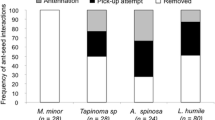Summary:
The overall distribution of Linepithema humile, introduced about a hundred years ago and now widespread in western and southern Portugal, has not notably changed in the last forty years. The ant is particularly common in sand and in clay loam soils but, inexplicably and despite otherwise favourable conditions, is largely absent in adjoining easterly mostly sandy loam soils associated with metamorphic rocks. In these circumstances there was a striking change in transition areas from exclusive dominance by L. humile to exclusive dominance by the competing native species, Crematogaster scutellaris and Pheidole pallidula, which was directly associated with the change in soil type. In a site with a particular sandy loam soil type (Vt) comprising adjoining patches colonized either by L. humile or native ants, the former occurred where there was a greater sand content. In oak planted sandy and Vt soils L. humile was present in cultivated or grazed ground but was replaced by C. scutellaris when there was well established scrub and ground vegetation. There was intense fighting at a transition line in one place with uniform tree and ground vegetation that supported large populations of L. humile and of native dominants on opposite sides of the transition. Here, the former had spread about 30 m per year between 1993 and 1996 compared with an estimated 800 m per year in the first 60 years after introduction. It is concluded that the dominant native C. scutellaris and P. pallidula in their favoured plantation habitats, and T. nigerrimum and T. hispanicum in some arable and pasture habitats can delay or prevent spread of L. humile in soils and vegetation conditions that also suit it. Although L. humile was present in most valley floors, its presence and abundance were not significantly related to valley conditions, and it was sometimes abundant at the tops of adjoining hillsides and in seasonally water-deficient sandy areas. Its association with some built-up areas was strikingly displayed by abundance in a town on inimical metamorphic-based soils that were uncolonized in immediately adjoining vegetationally favourable plantation and agricultural land. The direct and indirect effects of soil type on L. humile are analysed and discussed. Three habitats largely free of human interference – sand dunes with native trees and bare areas, a similarly patchily vegetated rocky river gorge and an eroded arête – may exemplify natural conditions exploited by L. humile in its native South America.
Similar content being viewed by others
Author information
Authors and Affiliations
Additional information
Received 27 March 1997; revised 11 July 1997; accepted 1 August 1997.
Rights and permissions
About this article
Cite this article
Way, M., Cammell, M., Paiva, M. et al. Distribution and dynamics of the Argentine ant Linepithema (Iridomyrmex) humile (Mayr) in relation to vegetation, soil conditions, topography and native competitor ants in Portugal . Insectes soc. 44, 415–433 (1997). https://doi.org/10.1007/s000400050062
Issue Date:
DOI: https://doi.org/10.1007/s000400050062




